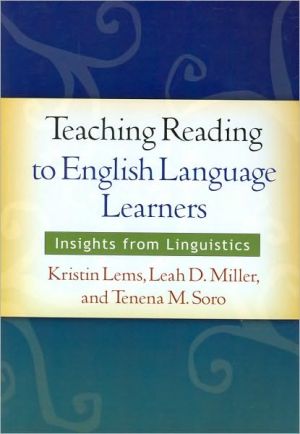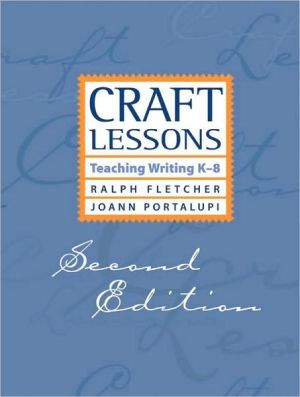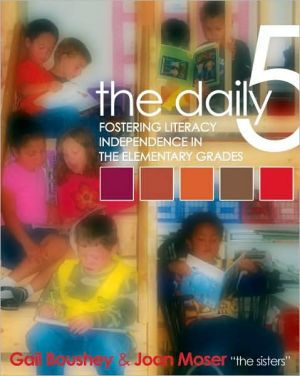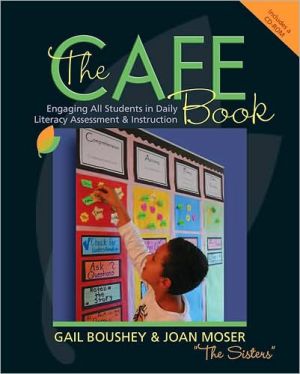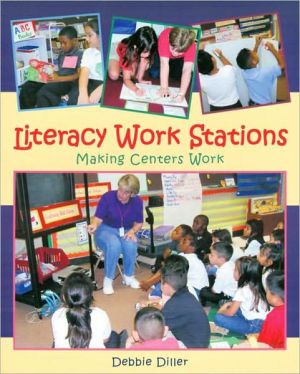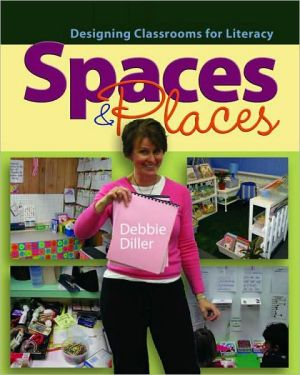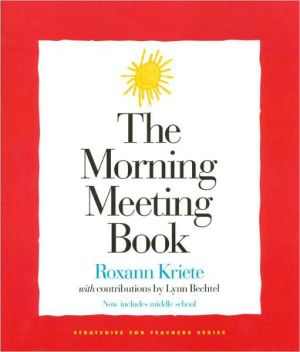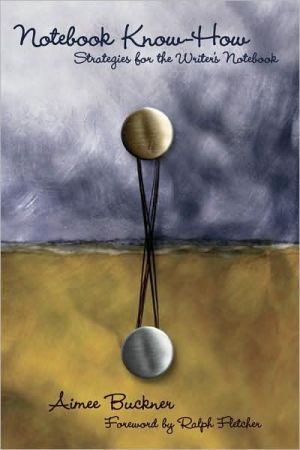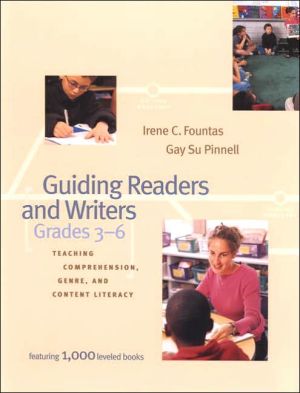Teaching Reading to English Language Learners: Insights from Linguistics
Written specifically for K–12 educators, this accessible book explains the processes involved in second-language acquisition and provides a wealth of practical strategies for helping English language learners (ELLs) succeed at reading. The authors integrate knowledge from two fields that often remain disconnected—linguistics and literacy—with a focus on what works in the classroom. Teachers learn effective practices for supporting students as they build core competencies not just for reading...
Search in google:
Written specifically for K–12 educators, this accessible book explains the processes involved in second-language acquisition and provides a wealth of practical strategies for helping English language learners (ELLs) succeed at reading. The authors integrate knowledge from two fields that often remain disconnected—linguistics and literacy—with a focus on what works in the classroom. Teachers learn effective practices for supporting students as they build core competencies not just for reading in English, but also for listening, speaking, and writing. Engaging vignettes and examples illustrate ways to promote ELLs’ communicative skills across the content areas and in formal and informal settings. Biography Kristin Lems, EdD, is Professor in the ESL/Bilingual Education Program at National-Louis University, where she directed a 5-year grant from the U.S. Department of Education in ESL teacher education in DuPage County, Illinois. She pursued her twin interests in reading and ESL through a doctorate in reading and language from National College of Education and a master’s degree in TESOL from the University of Illinois at Urbana–Champaign. Her doctoral dissertation on adult ESL oral reading fluency won a finalist award from the International Reading Association for Outstanding Dissertation of the Year. Dr. Lems spent 2 years as a Fulbright Scholar in Algeria doing inservice training of postsecondary EFL teachers, and wrote a book on ESL/EFL methods for the Peace Corps. Her coedited book, Fluency Instruction: Research-Based Best Practices, with Timothy Rasinski and Camille Blachowicz, was a finalist for the Frye Book Award of the National Reading Conference. Dr. Lems consults on reading and ESL in the Chicago Public Schools. She is also a professional folk singer and sings for children in schools and libraries in several languages, including Farsi, which she learned teaching in Iran. Leah D. Miller, MA, is Assistant Professor in the ESL/Bilingual Education Program at National-Louis University, and also teaches graduate linguistics courses at the University of Illinois at Chicago. She has served as coordinator of the ESL/Bilingual Education Program at National-Louis University for the past decade and has taught all of the courses in the program. In addition to doctoral coursework in linguistics at Northwestern University, Ms. Miller has a master’s degree in TESOL from Southern Illinois University. She is on the board of Illinois TESOL/BE, where she heads its Awards Committee, and serves as a consultant on issues related to ELL assessment and the WIDA standards. She has presented at TESOL conventions and meetings of the American Educational Research Association, the American Association for Applied Linguistics, the National Council of Teachers of English, and other prestigious venues. She has a keen interest in content-area ESL and linguistics, and, with Kristin Lems, codirected a Department of Education grant in ESL teacher education. Besides reading research, Ms. Miller’s passions include spending time with four adopted grandchildren and Jervis the cat, and reading dictionaries. Tenena M. Soro, PhD, teaches courses in linguistics, cross-cultural education, foundations, and reading for the ESL/Bilingual Education Program at National-Louis University. He has also taught courses in ethics and philosophy, linguistics, and social science at Columbia College, Northeastern Illinois University, and Northwestern University. He has a doctorate in linguistics and a Graduate Certificate in African Studies from Northwestern University, in addition to two undergraduate degrees from Université d’Abidjan, Ivory Coast. Dr. Soro’s dissertation included a linguistic analysis of his native language, Cebaari, and he is proficient in six additional languages. He has presented on linguistics and ESL topics at state and national conferences, including TESOL and the American Educational Research Association, and in 2008 he received the Outstanding Adjunct Faculty Award from National-Louis University. In addition to teaching, he is a serious student of yoga and meditation.
1. Big Ideas and Research That Guide the Profession2. First-Language Influence in Second-Language Acquisition3. ELL Oracy: Listening Comprehension and Oral Language Development4. Learning to Read, Write, and Spell Words in English as a New Language5. Using Morphemes to Learn Vocabulary 6. Word Formation Processes, Cognates, and Collocations7. “The Same, but Different”: Reading Fluency in English as a New Language8. Achieving Comprehension in L2 English Reading9. Writing to Learn in English across the Curriculum Glossary
\ Choice Reviews“The book''s strengths include the inclusion of classic and current educational and linguistic research as well as research-based classroom activities that promote the development of students'' listening, speaking, reading, and writing abilities....One of the best overviews of ''best practices'' in teaching ELLs that this reviewer has seen. Highly recommended. Graduate, research, and professional collections."--Choice Reviews\ \ \ \ \ Education Review"A timely contribution for practitioners looking for sound information...combines progressive pedagogical practices with language acquisition theory and research....An excellent resource for university literacy methods courses. Instructional leaders in schools, reading teachers and specialists, ESL teachers, and general education teachers would also benefit from this book. As classrooms become more diverse, a solid understanding of linguistic principles is a must and this book engagingly describes literacy and linguistic theories applicable to educators....The authors' extensive knowledge of both the reading and language acquisition processes provide a theoretically sound, yet practical and readable resource. The book provides the ''why'' and ''how'' for reading instruction in today's linguistically diverse classrooms and demonstrates it is possible to marry current literacy research and pedagogy with linguistics. Many teachers today have English learners in their classrooms and confess to not being sure of how to meet their language development and academic needs. This book offers both theory and very concrete direction."\ \ \ Tapestry Journal“Among the impressive elements of the book is its user-friendly nature….Makes linguistics comprehensible….Another positive feature of this volume is its practicality for reading specialists, ESL instructors, and mainstream teachers….The authors demystify the world of linguistics while still making it interesting and useful. In addition, the practicality of the text will be highly appreciated by working professionals and new teachers, alike. Thus, it is appropriate for the P-12 audience for whom they wrote it. However, due to its largely age-neutral activities, it can also be used by those who work with young adults in community colleges and pre-college intensive English institutes.”--Tapestry Journal\ \ \ \ \ \ Tapestry Journal"Among the impressive elements of the book is its user-friendly nature....Makes linguistics comprehensible....Another positive feature of this volume is its practicality for reading specialists, ESL instructors, and mainstream teachers....The authors demystify the world of linguistics while still making it interesting and useful. In addition, the practicality of the text will be highly appreciated by working professionals and new teachers, alike. Thus, it is appropriate for the P-12 audience for whom they wrote it. However, due to its largely age-neutral activities, it can also be used by those who work with young adults in community colleges and pre-college intensive English institutes."--Tapestry Journal\ \ \ \ \ Education Review"A timely contribution for practitioners looking for sound information...combines progressive pedagogical practices with language acquisition theory and research....An excellent resource for university literacy methods courses. Instructional leaders in schools, reading teachers and specialists, ESL teachers, and general education teachers would also benefit from this book. As classrooms become more diverse, a solid understanding of linguistic principles is a must and this book engagingly describes literacy and linguistic theories applicable to educators....The authors' extensive knowledge of both the reading and language acquisition processes provide a theoretically sound, yet practical and readable resource. The book provides the 'why' and 'how' for reading instruction in today's linguistically diverse classrooms and demonstrates it is possible to marry current literacy research and pedagogy with linguistics. Many teachers today have English learners in their classrooms and confess to not being sure of how to meet their language development and academic needs. This book offers both theory and very concrete direction."--Education Review\ \ \ \ \ From the Publisher"Reading educators, get ready to have a book at your fingertips that puts all the pieces together for teaching literacy to your ELLs! The authors weave together linguistic concepts with key concepts related to reading, covering both theory and practice. This is a welcome contribution for general education teachers, reading specialists, and, most importantly, ESL/TESOL teachers."--Susan R. Hinrichs, EdD, reading specialist, Winfield (Illinois) School District 34 "Superbly written. The explicit links to theories and methods of language instruction are clearly illustrated with examples and vignettes, providing teachers with a strong research base to inform their reading instruction. The authors include multiple language groups and provide a wealth of strategies for teachers to use. They have adeptly synthesized research from the fields of linguistics, language acquisition, and reading to create an incredibly useful resource."--Minda Morren López, PhD, College of Education, Texas State University "A timely, comprehensive, and significant contribution to the field. Using a language-based theory of learning as an organizing principle, the authors have produced a research-based book with clear linguistic insight and practical classroom suggestions. This is a useful, linguistically informed resource for teachers of ELLs."--Shondel Nero, EdD, Department of Teaching and Learning, New York University "This book presents the most current knowledge about key concepts related to linguistics and reading. Writing specifically for those without prior training in linguistics, the authors build the reader's knowledge in incremental steps and provide the scaffolding needed for comprehension. I heartily recommend this book as a text for undergraduate and graduate courses in TESOL and literacy methods. The sections entitled 'How Does this Look in the Classroom?' and 'Questions for Further Study' will be particularly useful for generating collaborative classroom discussions and promoting learning."--Kyle Perkins, PhD, Department of Curriculum and Instruction, Florida International University\ \
